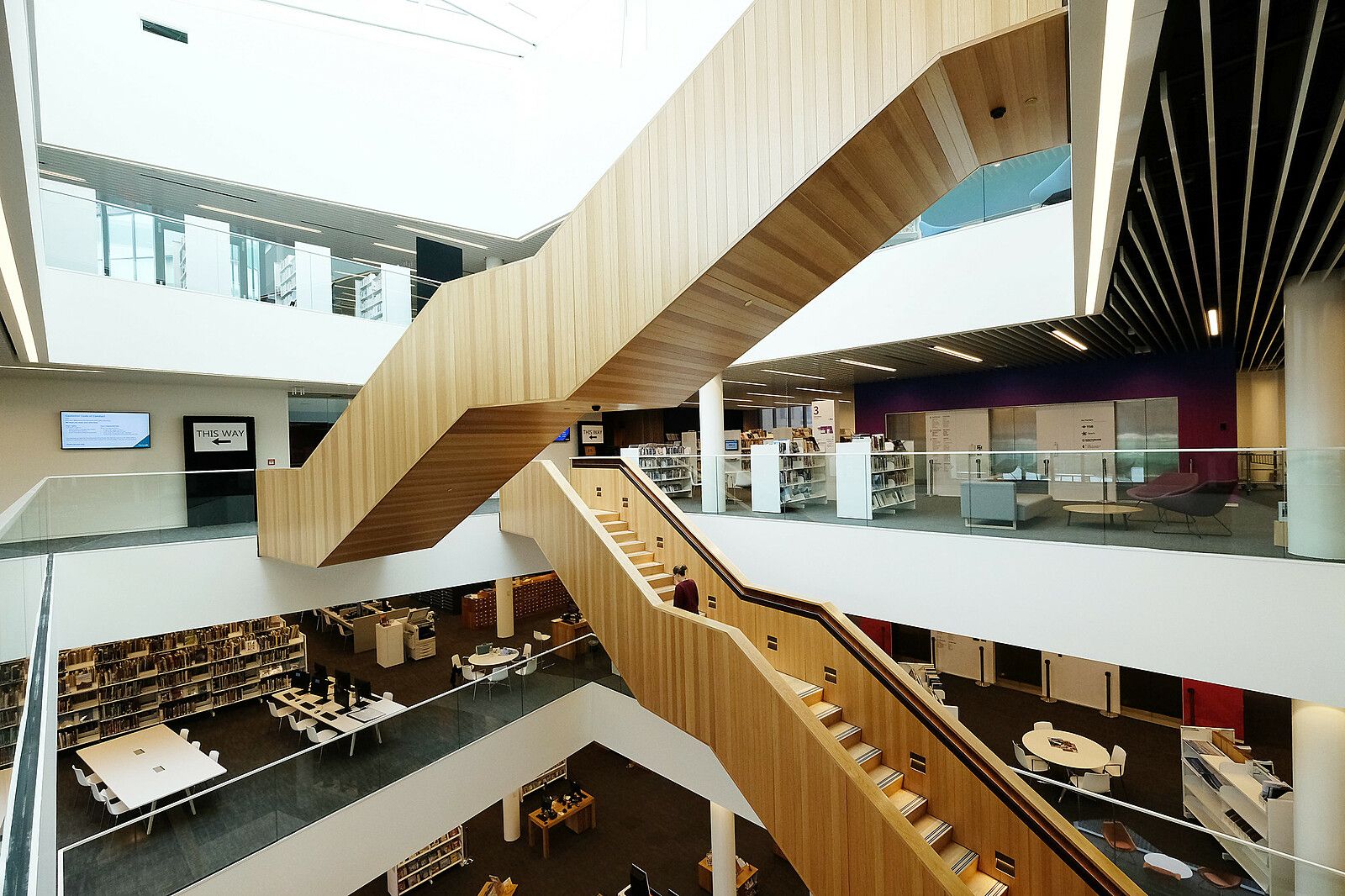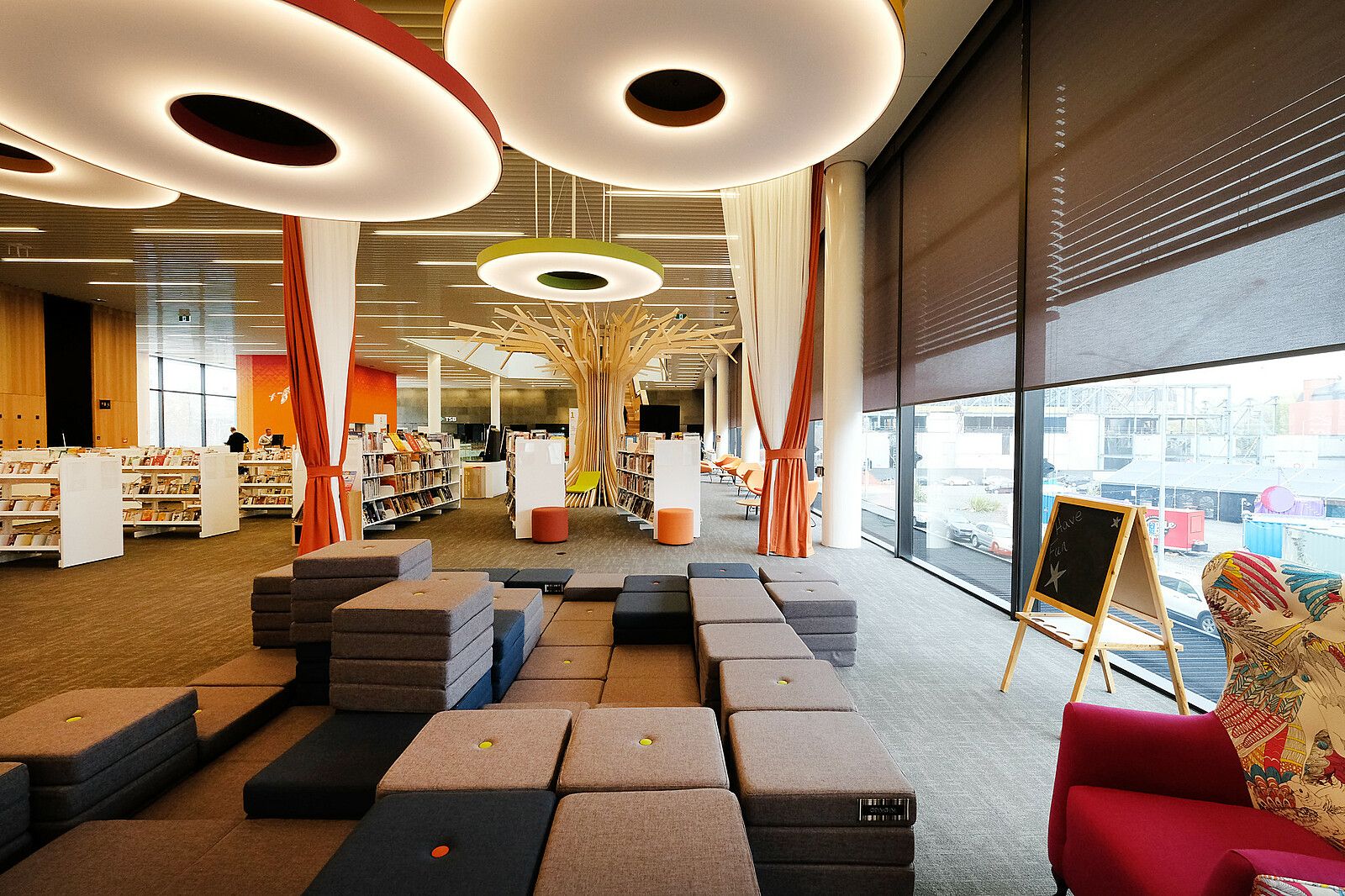Imagine a Library Like This
As one space closes, another opens. Salene Schloffel-Armstrong revisits the closure of the Elam Fine Arts Library and looks to where Samoa House Library is headed next.
As one space closes, another opens. We revisit the closure of the Elam Fine Arts Library and look to where Samoa House Library is headed next.
In March last year, The University of Auckland announced plans to close their purpose-built Creative Arts and Industries libraries, consolidating their collections into the General Library or off-campus storage facilities. The lofty reputations of each of these specialist libraries meant this news was met with a quickly escalating furore. Various forms of response, outrage and protest began to take shape from early April. A large number of past and present university students organised a Save Fine Arts Library (SFAL) group, which spearheaded a range of protest actions both online and on campus. Even after an unprecedented response to the proposal, and an enormous number of submissions – from individuals and organisations both locally and worldwide – the university confirmed the closures on 21 June. Following this announcement, the resistance took another direction, with an evolving group of SFAL members and others developing a plan for an alternative library space. These plans were formalised in the opening of Samoa House Library on 22 September 2018.
As the official closing date of The University of Auckland’s Fine Arts Library approaches – rumoured to be at the end of the second semester this year – the limbo period in which both the library and its simulacrum, Samoa House Library, have been operating within is about to end. This timing provides a useful point at which to reflect on the potential future of this project, as it moves forward from the rupture of its birth, as a reaction to the communal loss of another, beloved space, and to consider the platform as its own unique entity.
In imagining a future for Samoa House Library, I thought it may prove useful to situate the University of Auckland library closures and the subsequent emergence of this new space against a backdrop of global trends concerning librarianship, the design of library buildings and changing conceptions of these resources as physical spaces. As a former art-school student currently embarking on a doctorate in Geography at The University of Auckland researching the public library as space, I have been following these developments with both personal and professional interest. I feel the dialogue around the library closures and the future of Samoa House Library could be elucidated through a wider lens of comparison. There are numerous examples globally of libraries being embraced and recognised as contemporary community spaces, and these projects may illuminate a range of possible futures for Samoa House Library in particular, as well as for alternative structures of resource provision and education within Aotearoa.
The digitisation of library collections, and increasing online access to resources, is often weaponised as a political argument that construes physical library branches as irrelevant in the contemporary world
The trajectory of the library as a physical site appears to be diverging toward two incompatible futures. Across the globe, there are two main narratives that have emerged concerning libraries as service systems and as material spaces. The first trend is most clearly visible within the United Kingdom, where austerity politics have led to a significant devaluing of libraries as part of a more broadly decimated public sector, and physical library branches have experienced severe downsizing, privatisation and significant shifts to volunteerism. It was due to these forces that the UK lost 127 public libraries in 2018 alone. The digitisation of library collections, and increasing online access to resources, is often weaponised as a political argument that construes physical library branches as irrelevant in the contemporary world. Numerous UK councils framed the benefits of physical library branches as less tangible than the direct needs (such as housing supply and pension assistance) of their elderly or vulnerable citizens, and used this reasoning of provision to either increase or to slash funding across the sector.
In direct contrast to this, the second global trajectory emphasises the value of a physical library as a necessary civic space. This is an issue that has become increasingly relevant in recent years, given the global move towards the privatisation of public space and defunding of social services. Libraries have the capacity to address a raft of social problems, including digital exclusion (through providing access to computers and the internet) and more general social exclusion (through offering English language classes), as well as the simple warmth, sociality and shelter of an accessible space. This trend can be seen in the current surge of library construction in major cities across Scandinavia. This direction presents the library as a vital flagship space within a city, and as a physical location that has ongoing social value beyond the simple housing of material books. Dubbed a “library of a new era,” the Oodi library in Helsinki opened in late 2018 to celebrate the 100th anniversary of the city’s independence from Russia. It has been described as aiming to offer everyone an open, public urban space. Closer to home, this trend is also represented by the widely celebrated, newly built Tūranga library in Ōtautahi, which has been positioned as the feature point of the central city’s redevelopment. Prior to opening, Tūranga had predicted the patronage of around 3000 individuals every day, utilising the library as a “a multipurpose civic commons aimed at fostering community living as much as learning and literacy.” In fact, Tūranga welcomed 2500 visitors in the first 90 minutes alone on their first day open in October last year.
The University of Auckland Creative Arts and Industries library closures can be seen as symptomatic of this first trend – although instead of a national austerity climate as in the UK, these closures illustrate the university’s increasingly neoliberal take on institutional education provision and their ‘economic’ use of space. Although a library collection implies a desire to preserve resources for the future, in today’s political climate “just having a library and preserving its contents are no longer considered to be sufficiently meaningful actions if the library is not being used.”[1] Conceptions of what qualifies as ‘use’ appear to differ greatly between students and management at The University of Auckland. The emergence of Samoa House Library (facilitated as it is by an unpaid cohort of past and present Auckland University students) also sits within the narratives of volunteerism we see playing out in the UK, where libraries are being forced to employ volunteer labour in order to keep their doors open. However, the evolving space of this new library also clearly represents major elements of the second, pro-physical library trend.
While demonstrating the impact that a community location such as a public library has on the population is difficult, its removal – even temporarily – provides an opportunity to examine that role.[2]
Although there are valid questions around the future of the specialist book collections housed in the Fine Arts, Architecture and Music Libraries (especially given the rumours of a book incineration that took place with the closure of the Engineering Library), theoretically the books will simply be moved into the General Library collections. It is therefore clear that the impassioned community resistance to these proposed changes revolves directly around what the physical space of these buildings provides. Despite assurances that the books would stay within the library system, the organising presence that developed into the creation of Samoa House Library recognised that the loss of the Fine Arts Library was not just about the availability of these collections. It was about the loss of a physical site, and a replacement space was necessary to house the community the library had served – and that had grown increasingly visible in the wake of the proposed closures. Put simply, Samoa House Library can be described as an attempt to hold onto a piece of space. It is an act of resistance, an action that tries to open a new place for a community to inhabit. This act is aiming to sustain space for the young art community of Tāmaki Makaurau to act communally and build a collection of resources. However, against continual political and economic pressures, this may well be an ongoing process of crowdfunding and disaster mitigation.
As well as the recognition of a library as a physical space of community value, Samoa House Library clearly illustrates three other central tenets present in future-facing library spaces around the world. One prominent trend within contemporary librarianship is to conceive of the library as a “third place.”[3]A concept created in the early 1980s by the urban sociologist Ray Oldenburg, this theory represents a third place between an individual’s work and home spaces – a space that also engenders feelings of inclusion or comfort, and allows an experience of “easy sociability” within a wider community. The third place is referred to in media reports describing the new Tūranga library in Ōtautahi, illustrating the concept as representing “a place where you can meet people or be ‘alone together’, enjoying sharing a social and recreational space with others, even if you are not engaging directly with them.”
It seems that a room within Tāmaki Makaurau specifically maintained for creative communities is considered frivolous or unnecessary
Samoa House Library has the unique capacity to act as a third place for Tāmaki Makaurau-based artists, writers and makers, taking on a liminal space between the pressures of work or study and the potential precarity of housing experiences in this city. What a third place affords is another site in which individuals can feel a sense of belonging. In 2018, the gift of space – to rest in, to think in, to work in – is rare within the arts in Aotearoa, as emphasised by these recent closures and the accompanying shrinkage of available studio space within institutions (even if the Fine Arts Library space is converted into studios, its footprint remains smaller than the post-graduate studio facility (Elam B) that was closed at the end of 2018). Space for even the basic needs of accommodation is increasingly tenuous. Affordable, privately rented studio spaces are incredibly difficult to come by, and the length of use is often contingent on impending development of neglected commercial space. It seems that a room within Tāmaki Makaurau specifically maintained for creative communities is considered frivolous or unnecessary. Samoa House Library can allow space for creative work to be supported outside of a traditional institutional environment. The library has the capacity to operate as a studio or office space for a whole raft of creative students and freelancers. Tāmaki Makaurau is also currently experiencing a dearth of artist-run initiatives, and the emergence of Samoa House Library is very welcome in this climate. However, as of yet, the library is not experiencing a high volume of everyday patronage that utilises these potential functions. This will hopefully change as potential visitors become aware of the space’s presence over time, and as displaced Elam students search for something to fill the gap when their library officially closes at the end of this month.
New-build or future-facing libraries across the globe are also recognising the role the library can play in supporting makers across a range of creative disciplines. The importance of considering these communities within the design of public libraries has been emphasised in the Helsinki build. The first floor of Helsinki’s Oodi library includes a makers’ space, with tools and workshops accessible with a library membership. The central public library in Tāmaki Makaurau also incorporates a similar space, which focuses on gathering community through practices of creativity. Both of these makers’ spaces are focused on an equity of access to skills and tools, but also speak to a narrative of proximity. The value of having making spaces alongside library collections was central to the University of Auckland protests. Samoa House Library has further illustrated this desire for proximity, mimicking the Elam design in their new library space. Studio spaces are rented out next to the library room, bestowing the gift of proximity that will soon disappear from the university institution. Including space for practices of making within library collections has also been recognised as central to the design of the Tūranga library. The fourth floor of the new library is themed around auahatanga (creativity), allowing public access to a computer lab, virtual-reality equipment, an audio-visual studio, a production studio full of tools, as well as free classes and workshops. Perhaps the value of this inclusion and closeness with creative practice will be illustrated through the success of the Ōtautahi public library, and will further emphasise what will have been lost for the creative-industry students within the Tāmaki Makaurau institution.
I prefer to theorise Samoa House Library as a site that is continuously brought into being through the actions of numerous individuals
Contemporary librarianship narratives also employ language around the concept of ‘the commons’ to describe libraries as shared resources. Miriam Williams uses the Women’s Library in Sydney to define an ‘urban commons’ as a collective organisation “that is sustained by and sustains a community of people.”[4]Sharing many similarities with this specialist library space, Samoa House Library can also be described usefully as an urban commons. Unlike the concept of the library “enfolding a community,” I prefer to theorise Samoa House Library as a site that is continuously brought into being through the actions of numerous individuals. Williams describes the Sydney-based space as being maintained through everyday "practices of commoning.” She describes these various practices as expressions of care for the community as well as the physical space. Volunteers and organisers for the Women’s Library, as well as for Samoa House Library, all enact various practices that include organising events, making visitors coffee and sorting donations. However, care can also be enacted from a distance, in the form of book or monetary donations that represent expressions of interest in and support for the commons.
It is too early to predict a certain future for Samoa House Library – or, indeed, for public libraries worldwide. However, I personally believe there is reason to be optimistic. This specialist project sits closer alongside the aims of the contemporary future-facing library than its founders may imagine. Samoa House Library can be described as a third place, a library that includes makers within its design, and an ‘urban commons’ that is focused on being responsive to the needs and desires of their surrounding community.
Care from a distance is still a form of care, and represents a significant group of individuals and organisations that see value in this growing collection and shifting platform
They appear to be achieving their goal in creating an alternative library that operates as an open and evolving educational platform. The Boosted campaign that closed earlier this month raised the $10,000 required for securing their physical lease in Samoa House for 2019. This success illustrates that there is a significant wider community in support of this endeavour, although they may not be engaging with the library on an everyday basis. Care from a distance is still a form of care, and represents a significant group of individuals and organisations that see value in this growing collection and shifting platform. Samoa House Library has also recently launched their *curriculum* programme, which formalises their desire to exist as an alternative space of learning and education. I feel the direction this project takes will be central in shaping the function of the library looking forwards.
As we saw on the University of Auckland campus one year ago, the fight to keep this new space open will also be continuous and difficult. However, Samoa House Library’s intention to listen and shift accordingly shows an ideological position in opposition to that of the university management – and this alternative position may ensure their survival. Regardless of the length of time the library remains open – and I truly hope this is a permanent addition to the city’s cultural landscape – their claiming of space and place for their community has demonstrated that alternative frameworks can be built to respond to institutional failure. This will surely illustrate the wide potential for newly imagined futures regarding art and education within the city, and disrupt conceptions of who has the power to enact these radical changes.
[1]Ksenia Cheinman, “Creating Alternative Art Libraries,” Art Documentation: Journal of the Arts Libraries Society of North America 33, no. 1 (2014): 41–58.
[2]Liz Brewster, “The Public Library as Therapeutic Landscape: A qualitative case study,” Health & Place 26 (2014): 94–99.
[3]Ramon Oldenburg & Dennis Brissett, “The Third Place,” Qualitative Sociology 5, no. 4 (1982): 265–284.
[4]Miriam J. Williams, “Urban Commons are More-than-property,” Geographical Research 56, no. 1 (2018): 16–25.








